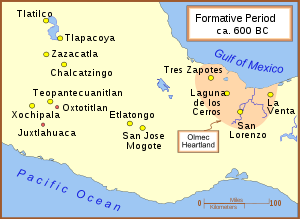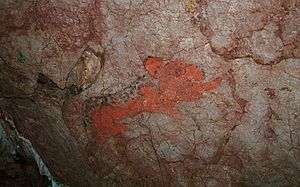142:
118:
24:
87:
193:
200:
A dozen skeletons have been found in the so-called Hall of the Dead, located midway between the entrance and the paintings. From their positions, some extended and some in a fetal position, and their condition, covered with a stalactite crust, the skeletons are assumed to be ancient interments.
133:
at a much smaller figure crouched to his side and is carrying a long snake or snakelike object. This 2 meter (6 foot) tall painting is one of the rare Olmec-style portrayals of human-on-human dominance, which some researchers interpret as a scene of
168:(1200-900 BC, uncalibrated)" in date. Juxtalhuaca is, so far as is known, unassociated with any large town of that period. It is also not known how Olmec-influenced art came to be painted hundreds of kilometres (or miles) from the
125:
The most well-known of the cave art is
Painting 1, which features a large bearded man with a black cloak, a striped tunic, and an elaborate headpiece. The arms and legs are covered with
153:
with green plumes, near a red jaguar whose large ears and eyes give it a youthful cast. A design that has provisionally been interpreted as a temple was found on a stalagmite.
109:
The site's paintings have been estimated to be over a kilometre down a long cavern: descent times are roughly two hours and some passages are partially filled with water.
444:
464:
218:
204:
Just before the paintings, a 250-foot (80 m) artificial canal was cut into the red clay floor of the cave. The purpose of this canal is not known.
156:
The cave paintings have been known since at least the 1920s, but were first professionally documented in the early 1960s by
Gillett Griffin of
469:
348:
47:
400:
439:
454:
264:
may have obscured the object so that it is seen as a snake-like object and a belt around the smaller figure.
165:
98:
in what is now a
National Park. The entire cave system is slightly over 5 km. The caves, also called
380:
176:" depict priests or rulers emerging from caves, and monuments and reliefs at the archaeological site of
449:
157:
17:
141:
459:
181:
117:
43:
192:
366:
223:
71:
38:
387:
213:
169:
150:
135:
330:
161:
23:
433:
129:
fur, and a small jaguar tail is even visible dangling down. The man is brandishing a
75:
63:
274:
177:
95:
86:
369:", Third Palenque Round Table, eds. Robertson, Merle Greene; Jeffers, Donnan Call.
67:
66:
cave, Juxtlahuaca walls contain the earliest sophisticated painted art known in
94:
The
Juxtlahuaca site is located some 45 km southeast of the state capital
103:
415:
402:
261:
278:
173:
51:
130:
126:
172:. Caves are prominent on many Olmec-style monuments: several Olmec "
106:. The caves are open to the public, but a local guide is required.
374:
Archaeology of
Ancient Mexico and Central America: an Encyclopedia
372:
Grove, David C. (2000) "Caves of
Guerrero (Guerrero, Mexico)", in
273:
The other two prominent displays of human-on-human domination are
260:
Some have seen this as a rope that is tied to the smaller figure:
191:
140:
116:
90:
Juxtlahuaca and other Olmec-related sites in the
Formative Period.
85:
59:
55:
22:
383:; University of Nevada - Las Vegas, accessed February 2007.
160:
and Carlo T. E. Gay, an
Italian businessman. Archaeologist
201:
Some have been partially buried as a result of a cave-in.
102:("Grottos of Juxtlahuaca"), are a favorite destination of
164:
has estimated that the paintings "might probably be
149:Also of note in Juxtlahuaca is a painting of a red
180:, to the north of Juxtlahuaca, also feature cave
349:Image of an Olmec ruler at Juxtlahuaca, Mexico
62:motifs and iconography. Along with the nearby
8:
337:, American Heritage Publishing, New York.
219:Olmec influences on Mesoamerican cultures
16:For the town by this name in Oaxaca, see
360:The Olmecs: America's First Civilization
196:A photo of the ruler and smaller figure.
235:
445:Cave sites in Mesoamerican archaeology
388:"Regional Variation in Maya Cave Art"
342:Mexico: From the Olmecs to the Aztecs
37:
7:
14:
392:Journal of Cave and Karst Studies
465:Archaeological sites in Guerrero
70:, and only known example of non-
381:Slide show on Juxtlahuaca cave
376:, ed. Evans, Susan; Routledge.
362:, Thames & Hudson, London.
355:Vol 79 No 305, September 2005.
1:
277:'s Monument 2 and Altar 4 at
394:, April 1997, p. 33-42.
365:Griffin, Gillett G. (1978) "
335:America's First Civilization
27:Painting 1 from Juxtlahuaca.
486:
344:London: Thames and Hudson.
15:
416:17.4392667°N 99.1594528°W
358:Diehl, Richard A. (2004)
347:Coe, Michael D. (2005); "
340:Coe, Michael D. (2002);
421:17.4392667; -99.1594528
367:Cresterías of Palenque
197:
146:
145:The feathered serpent.
122:
91:
35:Spanish pronunciation:
28:
470:Landforms of Guerrero
386:Stone, Andrea (1997)
195:
144:
120:
100:Grutas de Juxtlahuaca
89:
39:[xuʃtɬaˈwaka]
26:
158:Princeton University
18:Santiago Juxtlahuaca
412: /
44:archaeological site
440:Mesoamerican sites
317:Coe (1968), p. 99.
198:
147:
123:
92:
29:
224:Teopantecuanitlan
151:Feathered Serpent
477:
427:
426:
424:
423:
422:
417:
413:
410:
409:
408:
405:
379:Lachniet, Matt;
318:
315:
309:
306:
300:
297:
291:
288:
282:
271:
265:
258:
252:
249:
243:
240:
166:Early Preclassic
78:in Mesoamerica.
41:
36:
485:
484:
480:
479:
478:
476:
475:
474:
455:Caves of Mexico
430:
429:
420:
418:
414:
411:
406:
403:
401:
399:
398:
331:Coe, Michael D.
327:
322:
321:
316:
312:
307:
303:
298:
294:
289:
285:
272:
268:
259:
255:
250:
246:
241:
237:
232:
214:Maya cave sites
210:
190:
188:Other artifacts
170:Olmec heartland
136:human sacrifice
121:The red jaguar.
115:
84:
34:
21:
12:
11:
5:
483:
481:
473:
472:
467:
462:
457:
452:
447:
442:
432:
431:
396:
395:
384:
377:
370:
363:
356:
345:
338:
326:
323:
320:
319:
310:
301:
292:
283:
266:
253:
244:
234:
233:
231:
228:
227:
226:
221:
216:
209:
206:
189:
186:
162:Michael D. Coe
114:
111:
83:
80:
58:linked to the
42:is a cave and
13:
10:
9:
6:
4:
3:
2:
482:
471:
468:
466:
463:
461:
458:
456:
453:
451:
448:
446:
443:
441:
438:
437:
435:
428:
425:
404:17°26′21.36″N
393:
389:
385:
382:
378:
375:
371:
368:
364:
361:
357:
354:
350:
346:
343:
339:
336:
332:
329:
328:
324:
314:
311:
305:
302:
299:Griffin, p.4.
296:
293:
287:
284:
280:
276:
270:
267:
263:
257:
254:
251:Stone (1997).
248:
245:
242:Grove (2000).
239:
236:
229:
225:
222:
220:
217:
215:
212:
211:
207:
205:
202:
194:
187:
185:
183:
179:
175:
171:
167:
163:
159:
154:
152:
143:
139:
137:
132:
128:
119:
113:The paintings
112:
110:
107:
105:
101:
97:
88:
81:
79:
77:
73:
69:
65:
61:
57:
53:
49:
48:Mexican state
45:
40:
33:
25:
19:
407:99°9′34.03″W
397:
391:
373:
359:
352:
341:
334:
313:
304:
295:
286:
275:Chalcatzingo
269:
256:
247:
238:
203:
199:
178:Chalcatzingo
155:
148:
124:
108:
99:
96:Chilpancingo
93:
31:
30:
450:Olmec sites
419: /
308:Coe (2005).
290:Coe (2005).
68:Mesoamerica
54:containing
32:Juxtlahuaca
460:Wild caves
434:Categories
325:References
104:spelunkers
64:Oxtotitlán
353:Antiquity
262:flowstone
279:La Venta
208:See also
82:The cave
76:cave art
52:Guerrero
333:(1968)
131:trident
46:in the
182:motifs
174:altars
127:jaguar
56:murals
230:Notes
74:deep
60:Olmec
72:Maya
351:",
50:of
436::
390:,
184:.
138:.
281:.
20:.
Text is available under the Creative Commons Attribution-ShareAlike License. Additional terms may apply.




